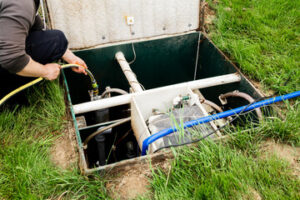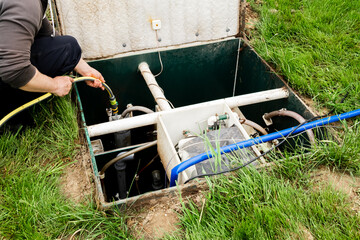Several technologies are being developed to improve the function, sustainability, and longevity of septic tank systems. These innovations reduce the risk of clogs, promote healthier microbial balance, and help protect groundwater.
Wastewater goes into the septic tank, where bacteria work to break down solids. The liquid layer is pumped into a drain field (also known as a leach field or soil absorption system). A distribution device helps evenly distribute wastewater throughout the drain field. Check out https://www.septictankarmadale.com.au/ to learn more.
 Waterloo Biofilters
Waterloo Biofilters
Waterloo Biofilters are free-draining aerobic wastewater treatment systems that combine biological sewage treatment with physical filtration. The innovative design of the engineered foam filter medium allows for separate flow paths of air and wastewater. The patented material resists clogging, has an optimized surface area-to-volume ratio, and requires minimal maintenance. The system can withstand a higher organic load and hydraulic capacity without plugging and does not generate aerobic sludge.
The septic tank’s effluent flows to the biofilter tank, where the bacteria form a biomass in the filter medium, digesting most of the organic matter in the septic tank effluent. This reduces the volume of septic tank effluent, which in turn cuts septic bed treatment costs by up to 50%. The system also removes up to 65% of phosphorous from the wastewater, making it ideal for cottages or any new development on lakes where phosphorous is of concern.
A lightweight HDPE tank is pre-plumbed at the factory, filled with the Waterloo Biofilter filtration medium, and shipped to the site fully assembled. The only moving parts are two high-quality, energy-efficient 1/2 horsepower effluent pumps that operate intermittently throughout the day. The treated sewage is pumped out of the basket biofilter and into a small, shallow soil disposal system such as a disposal bed, leaching field, or trench.
Each basket is surrounded by a perforated, odorless steel mesh screen that prevents solids from escaping the filter medium and reentering the water supply. The screen is attached to a stainless-steel riser with cast-in fittings for piping and a PVC junction box with strain reliefs for electrical wiring.
The patented aerated disposal system delivers consistently tertiary, sand filter quality effluent that is clear and odorless. The system can handle a wide range of site conditions including bedrock, clay, swamp, and small lots, and is especially effective in cold climates where other media-based trickling filters often struggle. The low power requirements and consistent operation of the Waterloo Biofilter make it a cost-competitive alternative to activated sludge or suspended growth systems. This highly reliable septic system also has the smallest footprint approved for use, helping homeowners preserve or increase the value of their properties by eliminating the need for unsightly raised mounds or extensive excavation.
Septic Tanks
As wastewater flows through septic tanks, natural processes take place. Solid waste sinks to the bottom and forms a layer of sludge, while fats, oils, and greases float to the top and create a layer known as scum. The remaining liquid effluent flows into the middle of the tank and undergoes a series of biological treatments as naturally occurring bacteria break down organic waste.
The resulting liquid effluent then flows through the septic tank’s outlet pipe, also called a drain field. As it percolates through the soil, the treated water encourages plant growth and provides nourishment for microorganisms. The process also cuts pollution by removing any bacteria from the wastewater before it enters the environment.
Depending on the septic system design, certain systems may include siphons that help to aerate the effluent before it drains into the drainage field. This helps to prevent clogging and extends the lifespan of the drainage field.
However, the effectiveness of septic systems is dependent on household habits and factors that impact the microbial breakdown of waste. For example, heavy use of garbage disposals can send too much solid waste into the septic system, and lint from synthetic fibers flowing from washing machines may reduce essential bacterial breakdown activity. It’s important to educate households on how to keep septic systems operating efficiently and effectively.
Keeping a septic system healthy is not only good for the environment, it’s good for homeowner budgets as well. When a home’s septic system is neglected, it can lead to expensive problems in the future, including sewage backups and other plumbing issues. Regular maintenance, including pumping and inspections, is the secret to a happy septic system.
Drain Fields
A drain field (also known as a leach field or soil absorption system) is the last part of the septic tank system where wastewater undergoes further treatment before being returned to the environment. It is comprised of a series of trenches or a bed lined with gravel or course sand. Perforated pipes buried in these trenches allow the wastewater to seep slowly into and through the soil. The bacteria in the soil then filter out pathogens, protecting underground water sources and waterways.
A septic tank holds the pre-treated wastewater long enough for heavy solid waste to settle at the bottom (forming sludge) and oil and grease to float to the top (as scum). The clear layer in between is the liquid that flows into the drain field.
Once the wastewater leaves the septic tank, it is distributed into a septic tank drainage system, which can be either a gravity or a pressurized system. The distribution box equally distributes the wastewater into lateral lines that connect to the drain field. The wastewater is then absorbed through the soil in the drain field, with the bacteria in the soil complexing and eliminating any remaining organic matter in the process.
To help protect the drain field, the use of non-biodegradable materials should be avoided. This includes chemicals, oils, and household cleaners, as they can harm the delicate bacteria in the system and hinder its ability to break down the wastes it treats. It’s also important to schedule annual septic system inspections and get your drain field pumped every three to five years.
Investing in a well-functioning drain field reduces environmental contamination and public health risks while decreasing repair costs. If your drain field is failing, several new technologies can be used to rehabilitate it. One such technology is jetting, which involves injecting high-pressure bursts of water into clogged or blocked lateral lines to break up sludge and debris. Another option is mechanical aeration, which involves fracturing the soil to improve flow. If these options don’t work, a new drain field may be necessary.
Pump Stations
Septic pump stations are a key part of septic systems in areas that lack the natural gravity necessary for wastewater flow. They serve to move wastewater from the septic tank to the drain field and can be either manual or automated. They work by combining the principles of energy efficiency with environmental considerations to reduce both energy consumption and sewage system maintenance costs.
A septic tank is a buried watertight container made of concrete, fiberglass, or polyethylene. It holds wastewater long enough to allow heavy solids to settle at the bottom (forming sludge) and oil and light materials to float to the top (forming scum). Depending on the system design, the tank may have an inlet baffle wall, outlet baffle, or both. The inlet baffle keeps surface scum from entering the septic tank inlet pipe and clogging the tank. The outlet baffle directs the liquid waste to a drain field or septic leach field without disturbing the settled sludge and scum.
The septic tank also has an effluent filter that protects the drain field from any sludge or scum that may be discharged from the septic tank. The effluent is then dispersed into the soil through a network of perforated pipes in gravel-lined trenches. The soil naturally treats the waste through evaporation, percolation, and uptake by plants.
The most advanced septic systems have several additional features, such as biofilters, aerobic treatment units, and sand filters that provide an even more thorough wastewater treatment. These septic systems are often more expensive to install and operate, but they can offer significant savings in the long run by reducing the amount of wastewater that is pumped from the home. Excess nutrients from failing septic systems can also contribute to water pollution by contributing to cyanobacteria blooms in nearby lakes, rivers, or other water bodies. These algae use up oxygen, causing fish and other aquatic life to die. Using an energy-efficient septic system with the proper drainfield system can help prevent these harmful bacteria from reaching drinking water wells and other local water bodies.


